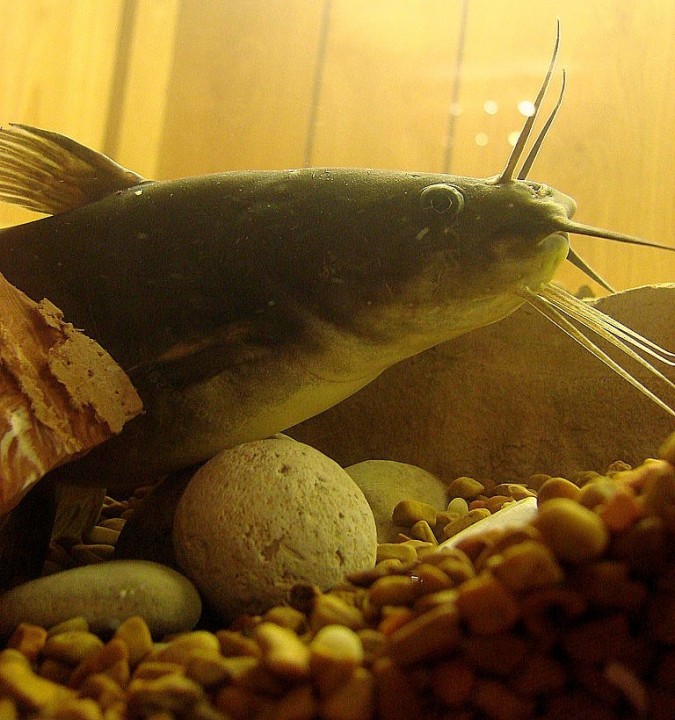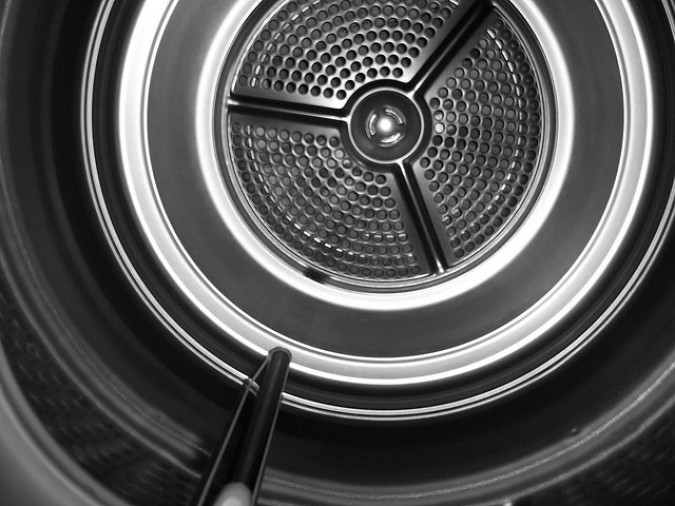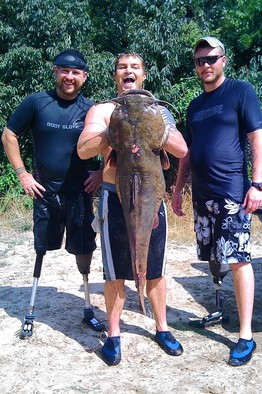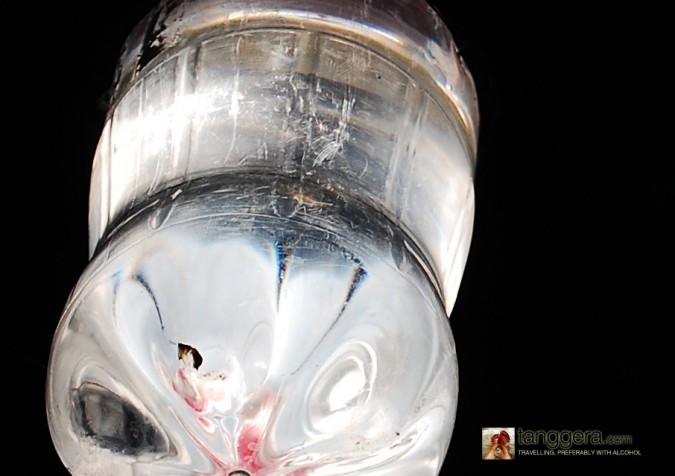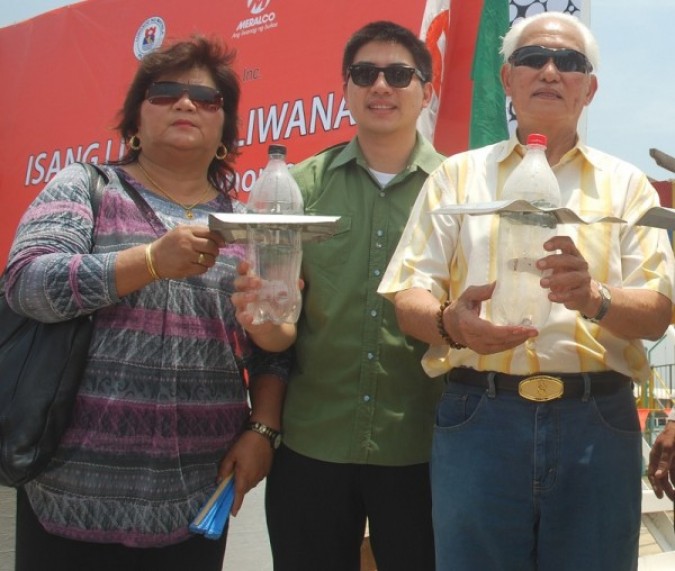Archive for 2011
Raising catfish in a barrel
Today I released 25 two inch long Brown Bullhead Catfish into my aquaponics system fish tank.
I bought these fish from a licensed aquaculture dealer I identified on the California Department of Fish and Game department website. The dealer recommended these catfish over other types of catfish because he said they grow better in aquaponics systems and are very hardy. Since I’ve lost all my full size catfish I bought at the supermarket, I needed to try something different.
While researching raising catfish, I discovered this 1973 article by Philip and Joyce Mahan about how to raise catfish in oil barrels. I would be scared to use an oil barrel since I’d be worried about contamination, but the article does impart useful information, including how to raise worms to use at catfish food.
Cross your fingers that my 25 new ‘roommates’ have a long and happy life!
Heat recovering clothes dryer to heat water
July 24, 2011 when I was falling asleep I thought of an idea I love. I plan to try this idea in my bus conversion.
Here’s the idea:
Place a car radiator in the exhaust flow of a clothes dryer. Pump water or another heat exchange liquid through tubing that connects the radiator to a heat storage tank. The fluid in that tank will warm, and that warm water can be piped through hydronic floor heating piping to heat the home.
This heat recovery could be meaningful, especially in households where the dryer gets used a lot.
Alternatively or in addition, the recovered clothes dryer heat could heat the domestic hot water supply, and that water could be used for the clothes washer. In effect the heat from the dryer could make the washer more energy efficient.
Alternatively or in addition, the recovered clothes dryer heat could be used to heat an aquaponics fish tank, which generally makes the fish eat more and gain weight faster. I understand that catfish grow fastest when their water temperature is 84 degrees fahrenheit. It takes a lot of energy to warm hundreds of gallons of water, so recycling heat from a dryer is a good idea.
Car radiators are cheap. I discovered this when buying the parts to build my sound proof engine box for my bus conversion.
My idea is so simple and inexpensive. It’s applicable to gas and electric dryers, and it makes sense for nearly every home in every country I can think of that has a clothes dryer. Why hasn’t such a system already been implemented?
Others have conceived of capturing waste heat from clothes dryers. Inventor Richard A. Brunner patented in the United States a system that from my quick read of the full text of the patent uses a heat exchanger to warm house air with moist air from the dryer vent. I didn’t see anything about heating water or using the hot water to heat the house or the water for a clothes washer, as I have described.
I suspect all the major clothes dryer companies have also considered heat recovery systems. The idea is not far fetched. I believe many industrial factories capture ‘waste’ heat from systems all the time for use elsewhere.
As I understand it, home heating forced air furnaces of high efficiency already recover heat from the first combustion process in a so-called second stage. I have been told these super efficient furnaces are trouble prone, but that they do work. I was advised not to buy one due to their complexity. But these dual stage furnaces apparently work by burning the exhaust, not just capturing heat from it. My dryer heat recovery system would be much simpler and cheaper to construct.
I have read about devices to capture heat from waste drain water, which often contains heated water. I suspect the amount of heat those devices recover is relatively small compared to the available heat that could be cost effectively recovered from a clothes dryer.
When I converted my Kenmore natural gas clothes dryer to propane so I could install it in my bus conversion, I temporarily operated the dryer with the front cover removed. I got to see the flame size, and I would say it’s similar to the size of flame that would be produced by running four stovetop cooking burners at once.
Yes, a lot of the heat is consumed evaporating water, but when I put my hand over the outside vent when my dryer is running, it seems like at least as much heat as a 1,500 watt space heater produces.
I suspect about 2/3rds of that heat could be captured in a hot water tank. A space heater produces about 5,000 btus of heat per hour, so 2/3rds of 5,000 is 3,333 btus. It takes about 1,000 watts of electricity worth say USD $.20 to run 2/3rds of a 1,500 watt space heater. So the captured heat from running a dryer by electricity for an hour is worth about USD $.20.
If the dryer is run for five loads a week, a dollar a week in energy is saved, or $52 a year. A dryer might last for ten years, so $520 worth of energy would be saved over the life of the dryer, or enough money to pay for the entire appliance.
But energy is getting more costly, so over ten years the savings might be 50% higher.
Every little bit helps.
Gas water heaters and furnaces should also have heat exchangers installed in their exhaust stacks. If a house is built with the hydronic piping for these heat exchangers in place, the cost to add these recovery systems should be affordable. However, it would be much better to eliminate the water heater and furnace in most homes, in favor of mandatory solar water heating for water and the air.
I think it is one of mankind’s dumbest moves to ignore the sun for most water and home heating worldwide, in favor of burning fossil fuels which really should be saved for fueling aircraft and spacecraft and making advanced plastics.
Why are we not burning oil at a rate such that it will last for 1,000 years? Or 10,000 years? Some say we’ve used up half the oil on the planet already, in what, 150 years? That’s a snap of the fingers. What will we do in three snaps? Go back to sailing ships? Yes, by then we might figure out cold fusion or oil from algae such that it really substitutes for oil. But what if we don’t?
While I’m carrying on here, I should say that clothes dryers themselves are rather ridiculous when air drying clothes makes them last longer and is free. Garages should have enough clothes lines to dry multiple dryer loads of laundry, and garages should have fans that exhaust to the outside so that drying times can be reduced substantially. Outdoor clothes lines should be allowed everywhere, by law, in the same way that television satellite dishes are allowed everywhere in the United States by law. As I understand it, no contract can take away the right to install your own satellite dish. The exception is if you have free access to a community satellite dish.
Some housing complexes have legally enforceable covenants that forbid outdoor clothes lines, and your house can be foreclosed on and sold if you violate these contractual regulations. Such provisions should be against public policy and automatically be void and unenforceable.
Sadly, wet clothes don’t have the powerful lobby that the satellite television reception industry pays a lot of money to employ.
Noodling = capturing catfish in the wild by hand or feet
The Wall Street Journal has gone downhill since it was acquired by News Corporation.
Even so, I still read it.
I feel guilty about it, but I loved the paper for so long it’s hard to stop reading it.
One of the things I love about the paper is it prints some crazy stories. This is not a News Corp. addition — the Wall Street Journal has published crazy stories for decades.
One of my favorite crazy Wall Street Journal articles was published about 20 years ago. The article spoke about how rat is served in Southern China in restaurants that specialize in serving just rat based dishes. The writing was so colorful and visceral I remember it well even today. Apparently rat causes nosebleeds for some diners. According to the story, eating rat can make you feel warm and perspire so much that you are inclined to take off your shirt in the restaurant, as some diners did in front of the Journal reporter.
The image of a group of bare chested men eating rat with blood running from their noses is hard to forget.
When I was in Wuhan, China in 2005 for the TeX Users Group International Typesetting Conference I asked the locals if there were any rat serving restaurants in the city. I was told no, that I would have to go further south for that. The article said the restaurant grade rats are raised using a free range technique on dedicated pasture surrounded by electric fencing. The article made it sound like the rats are fed well and are healthy and clean. I would try them. I want to try them. Hmmm, maybe I could buy some lab rats and try to cook them at home? What would my 4 roommates would say about that?
On May 16, 2011 the Wall Street Journal published a story that nearly is as captivating as the rat story — Long Arm of the Law Penalizes Texans Who Nab Catfish by Hand.
There is a way to fish for catfish called noodling. Here’s a description from the article:
Techniques vary. When the fisherman puts his hand into the hole where the fish is, the fish usually bites. Then he can grab the catfish by a lower-jaw bone, or, if he sticks his arm in deep enough into the fish’s body, he can poke his fingers through its gills.
But most important is controlling the tail, Mr. Webb says, which is usually done by the noodler wrapping his or her legs around the fish. “If you don’t get that tail immobilized, I don’t care how big or strong you are, you’re not going to whip that fish,” he says.
For extra reach, some practitioners stick their legs instead of their arms into dark underwater holes. Apparently, you can lose a leg noodling, judging from the shocking photograph accompanying the article, shown here, which shows three men. One has two legs, one has one leg and one has zero legs. They just caught a 60 pound catfish some 5 feet long, and they’re smiling widely.
I knew I would write about this story as soon as I read it. What I didn’t know at the time of publication was that I was soon going to be raising catfish in my backyard in San Francisco, California, USA.
I placed my aquaponics fish tank in my new Harbor Freight greenhouse last week, and I have catfish swimming in the fish tank. Don’t worry, they’re small enough I won’t lose my arms or legs anytime soon.
I have pan fried four catfish in recent weeks, and I like catfish more than Tilapia. I find catfish has more flavor than Tilapia. I am having trouble keeping the catfish alive, which is why I’ve been eating so much catfish recently. But I have read they are almost as easy to raise as Tilapia. I fear I am doing something wrong. I will figure it out and make a success of my catfish project.
Catfish is harder to prepare because you have to pull off the raw skin with large shop pliers, which is a physical chore and messy. But I’m getting better at it, and after ten more fish I predict I’ll be able to remove the skin in under a minute.
A while back I bought a used 275 gallon IBC tote for USD $120 that I plan to cut the top off of. I will then use this food grade tote as a monster fish tank. I should be able to raise 100 to 200 catfish at a time in this tank, which will give me so much fish I should be able to eat a full fish every two days or so, without depleting the stock. I have read that catfish are so efficient that they convert 2 pounds of feed into 1 pound of fish. The feed can be mostly worms you grow yourself using kitchen scraps as feed.
Smoke detectors should send activation warnings via text messages via Wi-Fi
Technology to connect to the Internet via Wi-Fi networks is small and inexpensive. Mobile phones and even camera memory cards accomplish this task.
I have an idea of how to use this technology to improve safety.
Combine a smoke/carbon monoxide detector with Wi-Fi circuitry so that when the detector activates text messages can be sent to people and entities that should be alerted.
There are already ‘Wi-Fi smoke detectors’ for sale, as a quick search will reveal. But these detectors are not for detecting smoke, but for covert video recording of a room. These products demonstrate that it’s easy to put a Wi-Fi transmitter into a smoke detector case.
The best of all worlds would be to combine an actual smoke/carbon monoxide detector with a video camera so that when the detector activates that a text message can be sent that includes a link so the message recipient can sign in to a webpage to observe the room the detector is located in. In this way, false alarms can potentially be identified from afar.
Current video fake smoke detectors cost a lot, but that’s because they are made in tiny volume. I bet a combination smoke, carbon monoxide, video Wi-Fi detector could sell for under USD $100 if they were required by building codes.
Finally, I think it’s time to add another feature to smoke/carbon monoxide detectors. I think detectors should also sense unburned gas such as natural gas and propane. For reasons I can’t understand, modern gas stoves don’t stop the flow of gas if there is no flame, so it’s possible to fill the house with gas without warning, other than the bad smell. Smell based warnings do no good for sleeping occupants. Gas detectors typically need more than a 9 volt battery to operate, so gas detectors usually are plugged into AC power. I think that’s fine, provided there is a battery backup to carry through power outages.
I would certainly pay USD $200 per detector for a gas/smoke/carbon monoxide/Wi-Fi/Video detector.
Would you?
TMC T80206 bus conversion
I’ve written about my love of bus conversions. I’ve shown you my first bus conversion, and wrote with sadness when I sold it in January 2011. I’ve written about my new conversion that I got in 2007, but I haven’t posted a high quality picture of it before.
I took this photograph of my 1994 TMC T80206 bus conversions in 2007 soon after I bought it on EBay for USD $10,000.
I love the sleek look, the low height and the fact that it has just two axles. Fewer axles mean cheaper bridge tolls and lower tire costs.
This vehicle only had about 368,000 miles on it when I bought it. Now it has about 371,000 miles on it, as I don’t drive it much.
I had it checked out before I bought it. Mark Waters, the chief bus mechanic at Coach America in San Francisco, California USA, said it was one of the cleanest used vehicles he had inspected. He said the engine computer only had 100 miles on it, which he said means it had just been fully replaced, as the internal mileage counter apparently can’t be reset.
I’ve known Waters since 2001 when I bought my first bus conversion. At the time he was co-owner of Pacific Coast Bus Service. Some time later Coach USA bought his company to get Waters to work for them, as I understand the story of the acquisition. According to WikiPedia, Coach USA West, where Waters worked, is now owned by Coach America and is known as Coach America.
Mark Waters is an exceptional mechanic, and I feel privileged to have had him work on my vehicles for the last decade. He knows both 2 stroke and 4 stroke engines, a rarity among bus mechanics these days. He had to replace a cracked cylinder on my 1967 MCI 5a, and he did the work correctly the first time.
There is no rust on my 1994 conversion as most of the metal in the vehicle is stainless steel or aluminum.
I will have this repainted white at some point as that’s the most efficient color for a habitable vehicle, because white paint reduces air conditioning requirements dramatically, and I hope to cool one room at a time exclusively with photovoltaic panels, as I’ve written about before.
Galco’s Soda Pop Stop sells 500 different kinds of soda
I drink soda in moderation — one serving every two days. I used to drink a lot of cheap Safeway brand soda that I bought on sale for USD $.88 per two liter bottle. I think part of my dramatic weight loss (190 pounds down to 165 pounds, and I’m 6’2”) over the last year may be attributed to cutting so far back on the soda.
In the last two years I’ve all but ceased consuming soda that contains high fructose corn syrup.
I happily pay extra at my favorite grocery store, Rainbow Grocery, for organic soda made with real cane sugar. I can taste the difference.
I only drink soda from the major soft drink brands about once a month, maybe at a movie theater or other venue where organic cane sugar soda isn’t sold.
Now that I’ve convinced myself that small soft drink brands produce a better product, I am thrilled to have found the following video produced by Galco’s Soda Pop Stop. This is a Los Angeles, California USA retail store that also sells over the Internet.
This is the most charming promotional store video that I’ve ever seen. It’s long yet worth watching all the way through.
You will learn something and be amazed at how diverse the soft drink market is. Some of these boutique bottlers have been at it since the 1800s.
According to the Soda Pop Stop website, the store itself has been around over 100 years. Here’s the text from their ‘About Us’ web page:
“Why Galco’s Soda Pop Stop? Because before there were shops, there were Stops!
The business began as a small Italian grocery store in Los Angeles, California. It has been family owned and operated for over one-hundred years. Although the focus of the store has changed to soda pop and beer from around the world (sorry folks we cannot ship beer!) we still maintain our Italian deli in the back of our retail store. We originally became known for our “Blockbuster” sandwiches which are made fresh daily.
The passion for soda began when John F. Nese was a child. His father’s best friend owned a soda pop bottling plant where John loved to visit in the 1950’s. At that time, he also spent his summers at Happy Camp. It was here that he would dream of how he could hook the natural, bubbling spring water, add syrup and siphon it to his elementary school’s drinking fountains. In 1995 John began increasing his assortment of sodas not only out of love, but also as a protest to some of the larger soda companies that were not offering him the same prices as his larger competitors. He figured why not support other small businesses such as his own?
It took a few years, but the idea finally caught on! People started journeying from far away places to get a look at the store with over 400 sodas. We were honored to appear on PBS’s “Visiting with Huell Howser” and the Food Channel’s “Unwrapped” series and German Televison (to name but three of our various television appearances). We have also appeared in Sunset Magazine, The Los Angeles Times, The LA Weekly, The Tokyo Times and various other newspaper features. He has also been a guest on the BBC and the Canadian Broadcasting System. Over the years, we have received letters, phone calls and e-mails from people relating their stories of where they were and what they were doing when they had their favorite soda for the very first time. John’s love of history and trivia extends to his sodas. People who visit the retail store are impressed with his ability to share an interesting fact about any soda of interest.”
Galco’s Soda Pop Stop store as of today has 345 ratings on Yelp, with an overall rating of 4.5 stars. That alone is an astonishing accomplishment, and the owner should be immensely proud.
I’d like to meet John Nese, the owner of Galco’s Soda Pop Stop. If Nese reads this, I invite him to friend me on Facebook here: Facebook.com/kevinlwarnock.
I invite all of my readers to friend me on Facebook.
Here’s the contact information for the Soda Pop Stop store:
Soda Pop Stop
5702 York Blvd
Los Angeles, California 90042 USA
(323) 255-7115
www.sodapopstop.com
BioLite stove charges cell phone while cooking
This BioLite brand stove produces a tiny amount of electricity that is enough to charge a cell phone or run an LED light.
About five years ago I was a judge for the business plan competition at the Center for Entrepreneurship and Technology at the University of California at Berkeley.
The winning team had a technology that would produce electricity when placed into a flame. Their plan was to sell in the developing world a product for about USD $10.00 that cooks could use to charge their cell phones. I don’t know what became of that company, or if the BioLite stove uses the same technology.
I had a long talk with the founder of the company at Berkeley both before and after the winners were announced. I recall that the technology was developed at Lawrence Berkeley National Laboratory. I was pleased with myself because I predicted this team would win, and they did.
I learned about the BioLite stove on TechCrunch, an AOL blog that covers the technology industry.
Litre of Light – nearly free solar lights made with plastic water bottles and bleach
Sometimes I learn of an idea that shocks me with its brilliance.
Today I will describe such an idea. It’s called the Litre of Light.
Here’s the summary from the project’s website, Isang Litrong Liwanag, which translates to ‘A litre of light’:
“Isang Litrong Liwanag (A Liter of Light), is a sustainable lighting project which aims to bring the eco-friendly Solar Bottle Bulb to disprivileged communities nationwide. Designed and developed by students from the Massachusetts Institute of Technology (MIT), the Solar Bottle Bulb is based on the principles of Appropriate Technologies – a concept that provides simple and easily replicable technologies that address basic needs in developing communities.”
A Solar Bottle Bulb is a clear water or soda bottle filled with tap water and a little bleach. This bottle in embedded into the roofs of houses, with part of the bottle outside, and part of it inside. There is sealant around the hole to keep the roof weather proof. When the sun hits the outside part of the bottle, a lot of light reaches the inside part of the bottle. The water inside the bottle makes the light omnidirectional, mimiking an electric light bulb. The bleach keeps the water clear for years. Without the bleach, the water would quickly turn green with algae. Without the water, there would be a bright spot on the floor, surrounded by relative darkness.
Each Solar Bottle Bulb produces about as much light as a 60 watt incandescent light bulb, according to the video transcript linked to in this sentence.
I wish I could take my Canon 5D Mark II into some houses with these bulbs installed and get some really high quality still photographs and video, to help spread the word about this really bright idea. Light bulb entrepreneur and proponent Thomas Edison would be pleased.
The beauty of the Solar Bottle Bulb is that it works and it’s really affordable, at about P150 to P200 (USD $4.66 at today’s exchange rate) per home, installed, according to Alfredo Lim, the mayor of Manilla in the Philippines, pictured above on the right. That 150 to 200 peso cost is per home, not per bulb.
I am going to install these in any eco home I build down the road. I have a big collection of glass bottles to choose from. I’m not sure if glass is as suitable as plastic, but I would prefer to use glass if it can be made to work reliably.
Hacking neighbor from hell
I have four roommates. I love having roommates, especially since we are all interested in urban homesteading.
One of the first things new roommates ask for when they move into my house is ‘what’s the wi-fi password?’
I have to write it down and hand it to them, because I use a complicated password dozens of characters long.
Am I being silly?
I don’t think so.
Have a look at this Wired article entitled Hacking neighbor from hell.
Here’s the first few paragraphs that sumarize this crazy story rather well:
“A Minnesota hacker prosecutors described as a “depraved criminal” was handed an 18-year prison term Tuesday for unleashing a vendetta of cyberterror that turned his neighbors’ lives into a living nightmare.
Barry Ardolf, 46, repeatedly hacked into his next-door neighbors’ Wi-Fi network in 2009, and used it to try and frame them for child pornography, sexual harassment, various kinds of professional misconduct and to send threatening e-mail to politicians, including Vice President Joe Biden.
His motive was to get back at his new neighbors after they told the police he’d kissed their 4-year-old son on the lips.”
Fortunately, one of the victims is a lawyer, and his firm had access to a network specialist that installed a packet sniffer to figure out what was happening. The sniffer logs led the FBI to raid the home of the neighbor, where lots of incriminating evidence was found, including the child pornography the criminal posted in the name of the victim.
This episode reminds me of the 1990 Melanie Griffith and Michael Keaton movie Pacific Heights, where a tenant terrorizes his landlord in an effort to get the landlord to sell the duplex at a low price to the tenant. The tenant stops at nothing, I recall, and even deposited a big box full of large cockroaches into the landlord’s unit via gaps around common water pipes that connected the units. Pacific Heights is one of those movies you remember a lot about even years after seeing it.
Hummer hits school bus
I found this picture years ago. Sadly, I can’t remember where I found it, or I would give the publication credit.
This photo appears to show what happens when you drive your Hummer sports utility vehicle into a school bus.
It sure looks like the Hummer driver was severely injured or killed. I hope I am mistaken.
It sure looks like there were no injuries to the bus driver or any of his or her passengers.
